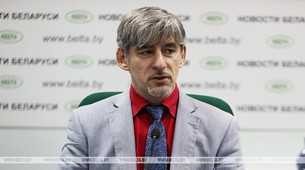Stress tests and follow-up plan of action to improve BelNPP safety

MINSK, 4 February (BelTA) - The national plan of action as a follow-up to the stress tests conducted at the Belarusian nuclear power plant (BelNPP) will improve the safety of the plant, Oleg Sobolev, a consultant with the Nuclear and Radiation Safety Department of the Belarusian Emergencies Ministry (Gosatomnadzor) told the media in BelTA's press center.
“The conclusions of the stress tests are an additional measure to improve safety and increase safety reserves. If any parameters do not meet the requirements of the IAEA or national law, such a situation is called a safety deficit, which must be eliminated. If, on the contrary, certain parameters exceed the requirements of the IAEA and national law, it means there is a safety margin,” said Oleg Sobolev.
Stress tests have been carried out at nuclear power plants around the world since the accident at Japan's Fukushima nuclear power plant, caused by the strong earthquake and tsunami. The European Nuclear Safety Regulators Group (ENSREG) has developed a procedure for stress tests in Europe. Such stress tests have been carried out at all nuclear power plants operating in Europe. “Despite the fact that at that time the nuclear power plant in Belarus was under construction, the country also voluntarily decided to carry out stress tests of its nuclear power plant in 2016-2018,” said Oleg Sobolev.

The first stage of this procedure was a self-assessment by the Belarusian nuclear power plant. The second stage was a national assessment under the overall supervision of Gosatomnadzor on behalf of the government. The third stage was the ENSREG partner inspection, as a result of which the European experts prepared a report with their conclusions.
The national action plan based on the results of the BelNPP stress tests was worked out in 2019. It took into account all suggestions and recommendations made at all three stages to improve safety and security. The national plan is available on the Gosatomnadzor website. It includes not only the list of actions but also a technical descriptive part. The document outlines 23 measures. Two of them are administrative and relate to planning and reporting, the other 21 are substantive.
According to Oleg Sobolev, the European stress test methodology evaluates several aspects. The first one is the resistance to floods and earthquakes, extreme weather conditions, the analysis of how the nuclear power plant will respond to adverse natural influences and their combinations. The second aspect is the operation of the plant under conditions of loss of power supply and coolant, and the third is the management of severe accidents. An analysis is conducted for each of the three topics, and measures are proposed to strengthen safety and increase safety reserves. Such approaches were applied during the stress tests of the Belarusian nuclear power plant as well.









